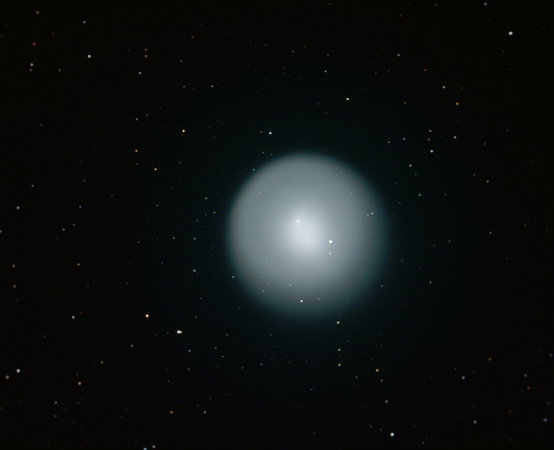Canon 350D Hap Griffin Baader Mod23x15sec at iso 1600
30 Darks/Flats/Bias
Celestron 9.25 with 0.63 reducerAstronomy Magazine Picture of the Day November 12, 2007Astronomy Magazine Weekly Newsletter November 17, 2007Comet 17P/Holmes underwent a massive outburst of 12 magnitudes from a very dim magnitude 17 to about magnitude 2½. By November 1, 2007 the comet's diameter was 7 times that of the planet Jupiter and expanding.On November 9th, a team of Hawaii astronomers led by Rachel Stevenson measured the diameter of the comet's expanding debris cloud: 1.4 million kilometers, slightly larger than the sun itself.
Speculation is that 17P exploded because there are sinkholes in its nucleus, giving it a honeycomb-like structure. The collapse exposed comet ice to the sun, which transformed the ice into gas.
Its startling outburst, however, has a precedent. The comet was also in a major eruption 115 years ago, in November 1892, when English amateur Edwin Holmes was the first to spot it. It reached 4th or 5th magnitude, faded in the following weeks, and then underwent a second eruption 2½ months after the first.The Outburst - The first person to notice something happening, according to IAU Circular 8886 (issued October 24th by the Central Bureau for Astronomical Telegrams) was A. Henriquez Santana at Tenerife, Canary Islands, shortly after midnight on the morning of the 24th local time. The comet was then about 8th magnitude, but within minutes Ramon Naves and colleagues in Barcelona, Spain, caught it at magnitude 7.3.
Internet discussion groups came alive with the news. "To my amazement, 17P had brightened to naked-eye visibility," exclaimed Bob King when he spotted Comet Holmes shortly before dawn in Duluth, Minnesota. "What a sight!" he posted to the Comets Mailing List. Alan Hale of Cloudcroft, New Mexico, concurred. To Hale (well-known codiscoverer of Comet Hale-Bopp) it appeared essentially starlike in a telescope until he switched to high power.


